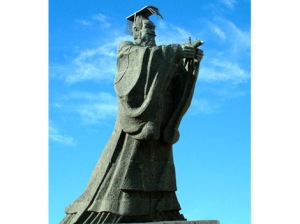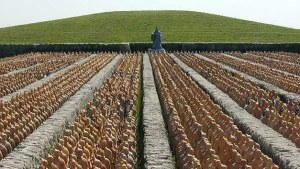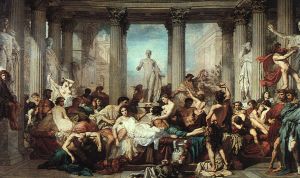The fateful year was 246 BCE, in the middle of January, Chinese New Year’s Day. And this day was truly an auspicious event. The calm winds did blow, and a new dynasty, the most powerful and yet, the shortest dynasty in Chinese history, had drunk from the poisoned cup of power. The great Chin Empire had arranged the sacred rituals for its grandiose reign. The infamous Black Emperor held tight to the wrath, once belonging to the worst of winters, and his holy name was, Ying Zheng.
Originally, the Chin rulers had fought as military knights under the great Zhou dynasty. But many centuries later, the Chin had finally received the mandate of Heaven, and like all new regimes and states built on the foundations of violence and legal crime, the emperor had a new capital built, called Xianyang on the western Wei River. Ying Zheng, as war commander and imperial Black Prince, took less than ten years to conquer all of his rival warlords and eventually unite the Middle Kingdom of China, both east and west, and north from the Yellow river to the south on the Yangtze river.
After Emperor Zheng’s sudden death about twelve years later, one of his sons, Zhao Zheng, or following his new name, Qin Shi Huang – the First Great Emperor, continued the Chin dynasty. He would last only a few years in power before his fateful assassination. The great Chin dynasty actually lasted only fifteen years, from 246-210 BCE.
Yet, this dynasty was the first to unite all the Chinas, the first to build on the Great Wall against the barbarians, the first to exterminate all the soldiers that knew the whereabouts of the Black Emperor, and then recreate them in lifelike quality in stone sculpture buried under the imperial sacred Earth. Chin Imperial power had first successfully used the political ideology of Legalism, under the advisers of Han Fei, Li Si, and Shang Yang.
Many philosophers and intellectuals in both antiquity and modern times have tried to formulate a theory, a law, or a truth that would explain to humanity the essence of human history. For some ancient historians, the understanding of history and conquest emerged from correct moral guidance, law systems, and aligning the actions of justice with fate or the Gods. Medieval historians often wrote about the attainment of both group discipline and group feeling, which enabled the triumph of the Spirit.
For others, it was the power of the Idea, the conception of the truth, while great leaders in history had obtained the access to the Eternal Mind, which led their empires and nations to victory. And for a few others, mostly of the Marxist persuasion, history was nothing but the struggle of social classes, where the poorer classes have been in constant war, movement and retreat versus the richer classes. All of these philosophers, intellectuals, and armchair historians were wrong.
The philosopher Nietzsche came the closest to understanding History, when he stated that history was not a subject worthy of study, for it was simply the study about how the strong, or the Masters, abused the weak, or the Slaves. This was true, but history has never been that simple. Humans have been very complex, have often thought too much, and have generally acted and reacted based on mental absurdities. But the cycles of history, and the rise and fall of great powers, empires, nations and states have all developed through the cultivation of the art of violence and the maintenance of such power. True power comes out of the genius, energy and will to do incredible acts of violence, brutality and cruelty.
All powerful state entities know this historical truth, including the sociopathic liars that now run the real United States Government-World Power. Historical entities that have fine tuned their methods of violence to greater legal webs of direction, such as prisons and concentration camps, massive laws codes, greater technological prowess in war, unbelievable controls in information and state secrets, amazing propaganda techniques, sophisticated uses of genocide, shocking acts of mass murder, various layers of legal state crimes, and the utter destruction of multiple enemies, have been the same entities that have triumphed through the attainment of power status on the world stage. Mao Tse Tung, the last known emperor of China, albeit a Communist one, stated that ‘all power comes out of the barrel of a gun.’ He was also partly right.
Violence has not just represented physical extermination, such as war, military divisions, guns, urban destruction, legal murder and state criminality. Violence has also signified institutional levels of brute force, such as laws, codes, work systems, schools, prisons, media propaganda, information gathering, intelligence spying, and surveillance mechanisms. The state apparatuses and empires that have successfully used and perfected all of those different levers of institutional violence have been the same empires that have achieved the most sublime victories on history’s pages for the battle of ideologies.
Think on the first great European empire, the Spanish Empire. At the beginning of the seventeenth-century, this Empire ‘where the sun had never set,’ had just murdered millions of indigenous people in the Caribbean, and yet it constructed a durable colonial regime from the Rio Colorado in New Mexico to the Rio Bio Bio in Chile for three hundred years. The ancient Assyrians also possessed great victories for hundreds of years, and they also held their special methods of torture and death in dealing with recalcitrant nobles that refused to respect them. The Chin Emperors of ancient China understood this truth fully through their ideological supports, called the Legalists.
For example, the Legalists advisers of the Chin ordered the confiscation of all illegal weapons. They also counseled the emperor on the nature of warfare, both internal and external. The emperor had to win the battle at all costs. The Chin also abolished hereditary noble privileges and they willfully executed scheming court eunuchs, massacred suspect villages and buried alive dishonest Confucian intellectuals. The Chin introduced forced labor conscription in order to build royal palaces, roads for war chariots, extensive canals, and gigantic walls that stretched thousands of miles in order to keep out the barbarians. They expelled non-Chinese foreigners and forcibly resettled minority cultures. The emperor did not just lounge in his palace, but he toured his empire on a war chariot accompanied by royal advisers and noble knights.
The Chin emperor forced the nobles into continual wars, so as to keep them occupied from parasitism. The Chin also employed the first court bureaucrats and did allow for some internal criticism. The emperors mandated a large family policy, larger agricultural tribute taxes, and the control of marriage partners, so that the poor would not marry the wealthy. The Great Emperor also demanded the burning of historical records with the final unification of Chinese legal and writing systems. According to the Legalists, the emperor kept a neutral stance on all policy, but his will reigned supreme handing out both punishments and favors, while he always favored the duress of the Law against favoritism and privileges.
After the overthrow of the Chin, another dynasty emerged to rule China. They had the name of the Han Dynasty, and unlike the Chin, they would rule for another 400 years. The Han emperors condemned the old Legalist methods of the Chin, but they also used similar violent methods in maintaining control. Sometimes the officials would cancel taxes, and other times they raised them. Sometimes the officials increased the number of laws, and other times they did not enforce them. The Han Chinese attacked Manchuria, Annam, (northern Vietnam), Mongolia and Korea, in order to expand their empire. The Han used Confucian scholars over Legalists, yet for the posterity of history, they used the same methods of violence and legal crime in order to keep up their power.
The historical lesson is simple. All states that want to advance in power and grasp their historical glory must increase their deeds of violence, brutality, criminality and cruelty. Violence does get the results, because the State, as historical entity, bathes in its own power to commit admissible violence and legal crime. There is no way to have a state without acts of torture, rape, imprisonment and murder. This truth goes for all states: democratic or parliamentary, republican or dictatorial, monarchic or oligarchic, theocracies or socialist juntas. Whether the methods are coup d’états or elections, resignations or palace revolts, the activities of the state speak only to unrestrained violence. Human culture changes, but the state has never changed – nor will it ever.









